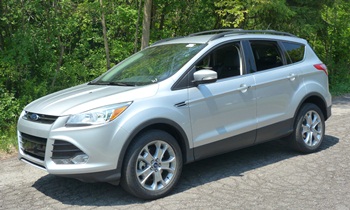Not long ago, Ford relied on low prices (even lower after hefty incentives) to sell its cars. But in the last few years it has sought, with a fair amount of success, to take a big step upmarket. The average transaction price of the 2012 Ford Focus has been about $5,000 higher than that of the 2011. Are they attempting as big a jump with the 2013 Escape?
Based on the vehicle, yes. The new Escape is essentially a Focus in crossover form. Like the Focus it was developed to be competitive in Europe, which has historically expected (and been willing to pay for) a much higher level of build quality and content in a compact vehicle.
 And the price? Well, compared to the 2012 the 2013 isn’t much more expensive. The old XLT plus SYNC is roughly equivalent to the new SE–and the new SE actually checks in a couple hundred dollars lower, $25,895 vs. $26.090. Adjusting for feature differences using TrueDelta’s car price comparison tool adds another $300 to the 2013’s advantage. This is despite the 2013 having a more powerful (178 vs. 171 horsepower) yet more efficient (23/33 vs. 21/28 MPG) engine and 18-inch wheels instead of 16s. So, compared to the 2012 the 2013 is looking like a much better value (assuming incentives are the same, though they won’t be).
And the price? Well, compared to the 2012 the 2013 isn’t much more expensive. The old XLT plus SYNC is roughly equivalent to the new SE–and the new SE actually checks in a couple hundred dollars lower, $25,895 vs. $26.090. Adjusting for feature differences using TrueDelta’s car price comparison tool adds another $300 to the 2013’s advantage. This is despite the 2013 having a more powerful (178 vs. 171 horsepower) yet more efficient (23/33 vs. 21/28 MPG) engine and 18-inch wheels instead of 16s. So, compared to the 2012 the 2013 is looking like a much better value (assuming incentives are the same, though they won’t be).
Ex-partner Mazda also has a new compact crossover, the 155-horsepower CX-5. The Escape SE lines up very closely with the CX-5 Touring, which lists for $1,205 less (but lacks a turbocharged engine). But what about more heavily loaded vehicles, with AWD, heated leather seats, sunroof, and nav? With more features, the Mazda’s advantage widens to $4,115 before adjusting for feature differences ($30,415 vs. $34,530), and about $2,350 afterwards.
Mazda lacks a powerful engine to go up against the Escape’s option of a 240-horsepower 2.0-liter turbocharged four. The closest match for a loaded Escape SEL or Titanium (which are priced very close together once features are accounted for) could well be the 260-horsepower Kia Sportage SX. The Fords list for $35,625 and $36,030, respectively, while the Kia lists for $32,200, a difference of at least $3,425. Adjusting for the 2013 Escape’s additional features cuts the gap to about $1,800.
Of course, Ford could be more focused on cross-town archrival Chevrolet than either Mazda or Kia. The 2012 Chevrolet Equinox LT with the above features lists for $33,440. The puts the 2012 $2,185 below the Escape. Adjust for feature differences, though, and the Escape undercuts the Equinox by about $250. For 2013 the Equinox’s price increases by $400, but it’s also gaining a few additional features, so after adjusting for both changes the net result will be about the same. Compare lightly optioned, lesser-engines, FWD vehicles, and the Chevrolet lists for $1,935 less before adjusting for feature differences, and about $1,000 less afterwards. The Equinox isn’t as feature-rich as the Escape, but it is considerably larger, roomier, and–with the 2013’s optional 301-horsepower 3.6-liter V6 engine–more powerful.
In the end, the pricing for the 2013 Escape doesn’t stack up quite like I expected. It’s a couple thousand dollars more expensive than the Mazda or the Kia, and also more expensive than the Chevrolet. But it’s not more expensive than the 2012 Escape. Apparently the Escape was already more expensive than its key competitors. But with the 2013 its higher price seems much more justified.